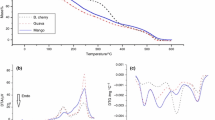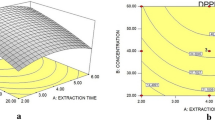Abstract
Taking into account the importance of natural antioxidants in the preservation of oils and fats, the present study evaluated the antioxidant action of five plant extracts in the control of soybean oil stability, by means of the accelerated techniques Rancimat and PDSC. These plants are rosemary (Rosmarinus officinalis L.), chamomile (Matricaria recutita L.), coriander (Coriandrum sativum L.), fennel (Foeniculum vulgare), and senna (Cassia angustifolia Vahl). The plant extracts and also the synthetic antioxidant BHT were added to the samples of crude soybean oil at the concentration of 1,000 mg kg−1. The values of total phenolic contents ranged from 8.7 ± 0.4 to 63.0 ± 2.3 mg GAE g−1 extract and a strong positive correlation was observed between the total phenolic contents and the overall antioxidant activity of the plant extracts. Such high values indicate a good protection of the analyzed soybean oil, moreover for the Rosemary extract that was superior to the remaining extracts. In the Rancimat technique the rosemary extract was more effective than the synthetic BHT antioxidant. The OIT values of Rosemary extract and the BHT antioxidant were equivalent, and the former, showed the highest phenolic contents among the extracts, for all the performed tests, confirming that it is a powerful natural source of antioxidants.


Similar content being viewed by others
References
Carlsson AS. Plant oils as feedstock alternatives to petroleum—a short survey of potential oil crop platforms. Biochimie. 2009;91:665–70.
Azam MM, Waris A, Nahar NM. Prospects and potential of fatty acid methyl esters of some non-traditional seed oils for use as biodiesel in India. Biomass Bioenergy. 2005;29:293–302.
German JB. Food processing and lipid oxidation. Adv Exp Med Biol. 1999;459:23–50.
Araújo KLGV, Epaminondas OS, Silva MCD, Lima AEA, Rosenhaim R, Maia AS, Soledade LEB, Souza AL, Santos IMG, Souza AG, Queiroz N. Influence of thermal degradation in the physicochemical properties of fish oil. J Therm Anal Calorim. 2011;106:557–61.
Shahidi F, Zhong Y. Lipid oxidation and improving the oxidative stability. Chem Soc Rev. 2010;39:4067–79.
Ramalho VC, Jorge N. Antioxidants used in oils, fats and fatty foods. Quim Nova. 2006;29:755–60.
Cordeiro AMTM, Medeiros ML, Santos NA, Soledade LEB, Pontes LFBL, Souza AL, Queiroz N, Souza AG. Rosemary (Rosmarinus officinalis L.) extract: Thermal study and evaluation of the antioxidant effect on vegetable oils. J Therm Anal Calorim. 2012; doi:10.1007/s10973-012-2778-4.
Reische, DW, Lillard DA, Eitenmiller RR. Antioxidants. In: Akoh CC, Min DB. Food Lipids: chemistry, nutrition and biotechnology. 2nd ed. New York: Marcel Dekker; 2002.
Yanishlieva NV, Marinova E, Pokorný J. Natural antioxidants from herbs and spices. Eur J Lipid Sci Technol. 2006;108:776–93.
Erkan N, Ayranci G, Ayranci E. Antioxidant activities of rosemary (Rosmarinus Officinalis L.) extract, blackseed (Nigella sativa L.) essential oil, carnosic acid, rosmarinic acid and sesamol. Food Chem. 2008;110:76–82.
Almela L, Sanchez-Munoz B, Fernandez-Lopez JA, Roca MJ, Rabe V. Liquid chromatograpic-mass spectrometric analysis of phenolics and free radical scavenging activity of rosemary extract from different raw material. J Chromatogr A. 2006;1120:221–9.
Mahmoud AA, Al-Shihry SS, Son BW. Diterpenoid quinones from (Rosmarinus officinalis L.). Phytochemistry. 2005;66:1685–90.
Mulinacci N, Romani A, Pinelli P, Vincieri FF, Prucher D. Characterization of Matricaria recutita L. flower extracts by HPLC-MS and HPLC-DAD analysis. Chromatographia. 2000;51:301–7.
McKay DL, Blumberg JB. A review of the bioactivity and potential health benefits of chamomile tea (Matricaria recutita L.). Phytother Res. 2006;20:519–30.
Lo Cantore P, Iacobellis NS, De Marco A, Capasso F, Senatore F. Antibacterial activity of Coriandrum sativum L. and Foeniculum vulgare Miller Var. vulgare (Miller) essential oils. J Agric Food Chem. 2004;52:7862–6.
Grosso C, Gerraro V, Figueiredo AC, Barroso JG, Coelho JA, Palavara AM. Supercritical carbon dioxide extraction of volatile oil from Italian coriander seeds. Food Chem. 2008;111:197–203.
Melo EA, Mancini Filho J, Guerra NB. Characterization of antioxidant compounds in aqueous coriander extract (Coriandrum sativum L.). Food Sci Technol. 2005;38:15–9.
Parejo I, Jauregui O, Sánchez-Rabaneda F, Viladomat F, Bastida J, Codina C. Separation and characterization of phenolic compounds in fennel (Foeniculum vulgare) using liquid chromatography-negative electrospray ionization tandem mass spectrometry. J Agric Food Chem. 2004;52:3679–87.
Oktay M, Gülçin İ, Küfrevioğlu Öİ. Determination of in vitro antioxidant activity of fennel (Foeniculum vulgare) seed extracts. Food Sci Technol. 2003;36:263–71.
Viegas C Jr, Rezende A, Silva DHS, Castro-Gambôa I, Bolzani VS. Aspectos químicos, biológicos e etnofarmacológicos do gênero Cassia. Quim Nova. 2006;29:1279–86.
Lombardo M, Kiyota S, Kaneko TM. Aspectos étnicos, biológicos e químicos de Senna occidentalis (Fabaceae). Rev Ciênc Farm Básica Apl. 2009;30:9–17.
Peron AP, Marcos MC, Cardoso SC, Vicentini VEP. Avaliação do potencial citotóxico dos chás de Camellia sinensis L. e Cassia angustifolia vahl em sistema teste vegetal. Arq Ciênc Saúde Unipar. 2008;12:51–4.
Singleton VL, Rossi JRJA. Colorimetry of total phenolics with phosphomolybdic phosphotungstic acid reagents. Am J Enol Viticult. 1965;16:144–58.
Silva TMS, Câmara CA, Lins ACS, Barbosa Filho JM, Silva SEM, Freitas BM, Santos FAR. Chemical composition and free radical scavenging activity of pollen loads from stingless bee Melipona subnitida Ducke. J Food Comp Anal. 2006;19:507–11.
Brand-Williams W, Cuvelier ME, Berset C. Use of free radical method to evaluate antioxidant activity. Food Sci Technol. 1995;22:25–30.
Frankel EN, Meyer AS. The problems of using one-dimensional methods to evaluate multifunctional food and biological antioxidants. J Sci Food Agric. 2000;80:1925–41.
Official methods and recommended practices of the American Oil Chemists’ Society. Fats, oils and lipid related analytical methods. 6th ed. Champaign: AOCS; 1993.
R. The R Project for Statistical Computing. In:http://www.r-project.org/ Accessed 06 may 2012.
Pereira RP, Fachinetto R, Prestes AS, Puntel RL, Silva GNS, Heinzmann BM, Boschetti TK, Athayde ML, Bürger ME, Morel AF, Morsch VM, Rocha JBT. Antioxidant effects of different extracts from Melissa officinalis, Matricaria recutita and Cymbopogon citratus. Neurochem Res. 2009;34:973–83.
Schwarz K, Bertelsen G, Nissen LR, Gardner PT, Heinonen MI, Hopia A, Huynh-Ba T, Lambelet P, McPhail D, Skibsted LH, Tijburg L. Investigation of plant extracts for the protection of processed foods against lipid oxidation. Comparison of antioxidant assays based on radical scavenging, lipid oxidation and analysis of the principal antioxidant compounds. Eur Food Res Technol. 2001;212:319–28.
Celiktas OY, Bedir E, Sukan FV. In vitro antioxidant activities of Rosmarinus officinalis extracts treated with supercritical carbon dioxide. Food Chem. 2007;101:1457–64.
Moreno S, Scheyer T, Romano CS, Vojnov AA. Antioxidant and antimicrobial activities of rosemary extracts linked to their polyphenol composition. Free Radic Res. 2006;40:223–31.
Nogala-Kalucka M, Korczak J, Dratwia M, Lampart-Szczapa E, Siger A, Buchowski M. Changes in antioxidant activity and free radical scavenging potential of rosemary extract and tocopherols in isolated rapeseed oil triacylglycerols during accelerated tests. Food Chem. 2005;93:227–35.
Liu X, Dong M, Chen X, Jiang M, Lv X, Yan G. Antioxidant activity and phenolics of an endophytic Xylaria sp. from Gingko biloba. Food Chem. 2007;105:548–54.
Freire LMS, Filho JRC, Moura CVR, Soledade LEB, Stragevitch L, Cordeiro AMTM, Santos IMG, Souza AG. Evaluation of the oxidative stability and flow properties of quaternary mixtures of vegetable oils for biodiesel production. Fuel. 2012;95:126–30.
Santos NA, Damasceno SS, Araujo PHM, Marques VC, Rosenhaim R, Fernandes VJ Jr, Queiroz N, Santos IMG, Maia AS, Souza AG. Caffeic acid: an efficient antioxidant for soybean biodiesel contaminated with metals. Energy Fuel. 2011;25:4190–4.
Boleslaw K. Evaluation of activities of antioxidants in rapeseed oil matrix by pressure differential scanning calorimetry. Thermochim Acta. 1993;213:135–46.
Acknowledgements
The authors acknowledge the Brazilian agencies FAPEAM, Fundação de Amparo a Pesquisa do Estado do Amazonas, by the Ph. D. scholarship, and to MCT and FINEP.
Author information
Authors and Affiliations
Corresponding author
Rights and permissions
About this article
Cite this article
Cordeiro, A.M.T.M., Medeiros, M.L., Silva, M.A.A.D. et al. Rancimat and PDSC accelerated techniques for evaluation of oxidative stability of soybean oil with plant extracts. J Therm Anal Calorim 114, 827–832 (2013). https://doi.org/10.1007/s10973-013-3036-0
Received:
Accepted:
Published:
Issue Date:
DOI: https://doi.org/10.1007/s10973-013-3036-0




